Читать книгу Graph Spectral Image Processing - Gene Cheung - Страница 33
1.5.2.2. Design of perfect reconstruction transforms: decimated case
ОглавлениеConstructing perfect reconstruction graph transforms with sampling is much more difficult than the undecimated version. However, it is required as the storage cost can be increased tremendously for the undecimated versions, especially for signals on a very large graph. Though the general condition is given by equation [1.42], the challenges are designing and choosing the appropriate sampling operator Sk and the appropriate filters hk(L) and gk(L). The perfect reconstruction condition can be satisfied with proper sets of these.
Various methodologies have been proposed in literature with different strategies. The recent methods of such transforms are summarized in Sakiyama et al. (2019c). We have omitted these details because they are beyond the scope of this chapter. Instead, some design guidelines are listed as follows:
– Sampling operator: In GSP, two different definitions of sampling operators exist (Tanaka et al. 2020; Tanaka 2018; Tanaka and Eldar 2020). One is vertex domain sampling, which is an analog of time-domain sampling. The other is graph frequency domain sampling, which is a counterpart of the Fourier domain expression of sampling. Both are not interchangeable in general, and have their own advantages and disadvantages.
– Localized transform: As mentioned later in section 1.6.5, polynomial filters are localized in the vertex domain. Furthermore, if all filters are polynomials, the entire transform can be eigendecomposition free, and thus, its computation decreases significantly.
– Flexible design adapting various spectra: Different graphs have unique eigenvalue distributions, and different graph operators have unique characteristics. Additionally, we sometimes encounter repeated eigenvalues. A unified design strategy is required for representing various graph signals sparsely.
